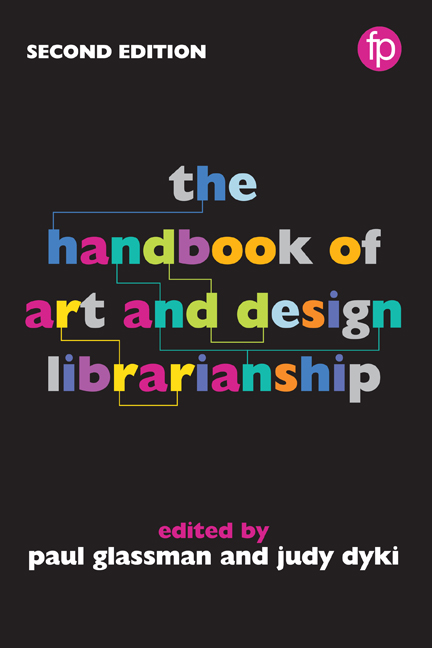Book contents
- Frontmatter
- Contents
- List of figures and tables
- Notes on contributors
- Foreword
- Preface
- Part I Roles and responsibilities
- Part II Materials and collection management
- Part III Teaching and learning
- 14 Embedded in their world: moving mentally into the studio environment
- 15 Teaching with threshold concepts and the ACRL Framework in the art and design context
- 16 Teaching by the book: art history pedagogy and special collections
- 17 Metaliteracy in art and design education: implications for library instruction
- 18 The art of evidence: a method for instructing students in art history research
- 19 ‘I want students to research the idea of red’: using instructional design for teaching information literacy in the fine arts
- 20 Cultural differences and information literacy competencies
- Part IV Knowledge creation
- Part V The physical environment
- Part VI Promotion and sustainability
- Appendix Library profiles
- Index
14 - Embedded in their world: moving mentally into the studio environment
from Part III - Teaching and learning
Published online by Cambridge University Press: 08 June 2018
- Frontmatter
- Contents
- List of figures and tables
- Notes on contributors
- Foreword
- Preface
- Part I Roles and responsibilities
- Part II Materials and collection management
- Part III Teaching and learning
- 14 Embedded in their world: moving mentally into the studio environment
- 15 Teaching with threshold concepts and the ACRL Framework in the art and design context
- 16 Teaching by the book: art history pedagogy and special collections
- 17 Metaliteracy in art and design education: implications for library instruction
- 18 The art of evidence: a method for instructing students in art history research
- 19 ‘I want students to research the idea of red’: using instructional design for teaching information literacy in the fine arts
- 20 Cultural differences and information literacy competencies
- Part IV Knowledge creation
- Part V The physical environment
- Part VI Promotion and sustainability
- Appendix Library profiles
- Index
Summary
Introduction
The artist's studio is not a natural environment for a librarian. To the unfamiliar, production in the studio may be disorganized, messy and non-linear. What is being made is often difficult, if not impossible, to classify. Descriptions of the work being created are often vague, couched in metaphors and full of synonymous terminology. To a library professional, trained in a world of classification, organization and controlled vocabulary, the studio environment is a foreign land. As for visitors to a foreign land, there is always the temptation to evaluate an unfamiliar environment based on what is familiar. Librarians of the past thought practising artists ‘do not want to learn library systems; some cannot read very well, many cannot verbalise their needs, and frequently cannot evaluate information’ (Hemmig, 2008, 349). In an early text on library instruction, the authors stated that they did not include a discussion of fine arts instruction because the fine arts ‘depend less on person-to-person communication than they do on talent, inspiration, perseverance, and opportunity – all fragile assets, the successful combination of which is notoriously unpredictable’ (Teague, 1987, 99). Art and design practitioners have also noted the disconnection between traditional library services and their creative production. In the essay ‘The Culture of Academic Rigour: does design research really need it?’ John Wood, former Deputy Head of the Fine Arts Department at Goldsmiths University, states that ‘competitive professional practices do not facilitate long periods in the library, and many designers succeed commercially without much contextual reading and writing’ (2000, 44).
Although these sentiments might seem dated to a contemporary librarian, there is an element of truth in them. The average art and design student probably does have little interest in learning library systems because most systems rely on a textual or verbal mode of access. Many cannot verbalize their information needs because they often think in the abstract, and their ideas cannot be easily classified. Their needs are unpredictable because successful art and design is often interdisciplinary and almost always novel. They are not skilled in the rigour of academia because it is not a necessary component of artistic communication.
Information
- Type
- Chapter
- Information
- The Handbook of Art and Design Librarianship , pp. 139 - 146Publisher: FacetPrint publication year: 2017
Accessibility standard: Unknown
Why this information is here
This section outlines the accessibility features of this content - including support for screen readers, full keyboard navigation and high-contrast display options. This may not be relevant for you.Accessibility Information
- 1
- Cited by
